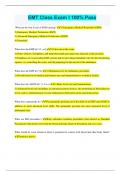Samenvatting
Summary articles for 1JV10
- Vak
- 1JV10 (1JV10)
- Instelling
- Technische Universiteit Eindhoven (TUE)
Summary of the articles for the course : Work and Organizational psychology: Advanced. Contains summaries of: - De Dreu, C. K. W., Beersma, B., Steinel, W., & Van Kleef, G. A. (2007). The psychology of negotiation: Principles and basic processes. In A. W. Kruglanski & E. T. Higgins (Eds.), Social p...
[Meer zien]













